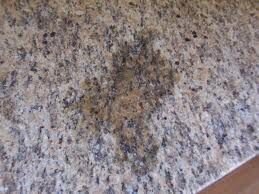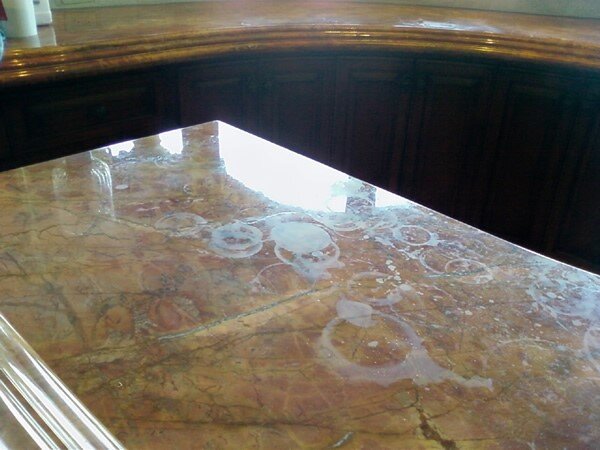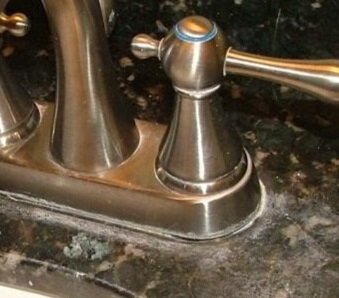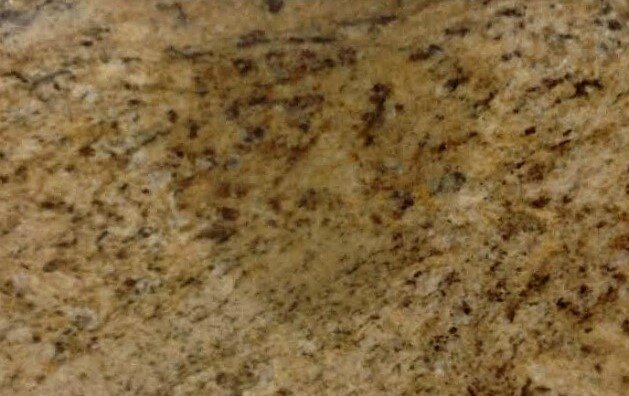Caring for Your Granite
Granite countertops are both durable and beautiful, which is why granite is such a popular choice for homeowners who are selecting the materials for new home construction and for those who are remodeling and want a kitchen that is both striking and practical. Caring for granite is different from caring for other countertop materials because granite is a natural stone that can be stained or damaged over time. Some maintenance is required to keep the dramatic look of granite at its best and brightest.
Light Daily Cleaning
Use a lint-free cloth or paper towel and a specially formulated granite cleaning product regularly to clean the counter, then dry the area with a separate clean cloth or paper towel. Do not use common abrasive cleaners, which can destroy the protective sealant on the granite. The absolute best product to use to clean your granite counter tops is warm water, a clean lint free rag and the blue Dawn dish detergent. You do not need anything “special”, just a clean rag, water and mild soap!
Spills
In the kitchen, spills on the countertop may be a daily occurrence, and the quicker you clean them up, the less potential damage to your counters. As soon as possible, blot the spill with a soft cloth or paper towel, then clean the area with a granite cleaner or warm water and mild detergent and dry with a clean cloth. Remember to blot, not wipe, because wiping can spread the spill. Granite counter- tops can and will stain if not cared for properly. Even when sealed the surface of your granite counter tops are full of microscopic pores that can be susceptible to staining and absorption.
Heat
Granite is extremely durable. Though placing a hot pot or pan on it briefly might not damage it at that one instance, it’s best to always use a trivet beneath it, especially if you need to set a heated pan down for longer than a few seconds. As tough as granite is, extreme changes in temperature can harm or even crack it. Avoid the problem by using something between the hot pan and the surface of the counter. Especially use a trivet between your granite and a Crockpot or any electric cooking surface.
Practical Preservation
Never stand on granite countertops. Use a ladder to reach lights that need changing.
Use a cutting board. It may be tempting to use the granite surface to slice foods, but don’t do it. While granite is scratch resistant, it isn’t completely impervious to scratching. And you’ll also save your knives, which are not as hard as granite and will become dull quickly if used directly on the stone.
Don’t skip regular cleaning. Even tiny particles can potentially affect the stone.
Use a mat or a trivet under anything ceramic, like a vase or kitchen utensil holder, to keep countertops scratch-free.
Use a mat or a trivet under any electric cooking surface to resist heat and damage from spills and splatters.
Clean surface daily with a mild detergent, warm water and clean lint free rag. Dry counter tops with a clean, lint free towel.
How to Clean Marble – Polishing Your New Marble Countertops
Marble is a beautiful choice for kitchen countertops, bathroom vanity tops, fireplaces and more. Marble is a wonderful natural stone with a very nice finish, but marble – like many things – can be damaged over time after much wear and tear. So how do you clean marble countertops or polish your marble countertops, fireplaces, vanities, etc. to keep the marble looking bright and shiny? There are some very simple tips for cleaning marble that you should follow when you decide to have marble in your home.
The first step in cleaning marble is to prepare the marble for cleaning. Prepare the surface of the marble by removing all dirt, grime, grease, waxes and stains with a commercial stone cleaner. You want to remove all these contaminants from your marble first so that you don’t force them deeper into the surface when polishing the marble. After you decide to have marble in your home – whether you have marble countertops or a marble fireplace – make sure you know how to properly clean and polish marble so you can keep your marble beautiful and long-lasting.
If you have even a small piece of marble in your home, consider yourself fortunate to be in the presence of one the most beautiful stones around. Marble is a limestone that has metamorphosed through heat and pressure, and in the process mixed with natural elements to produce the colors and intricate veining that has so many people pining away for it. And who could blame them? If only you didn’t have to keep it clean…
There are two very important things to know when wondering how to clean marble. The first is this: marble is not granite. People often confuse the two, or lump them together, but there are some major differences between marble and granite – mainly, that marble is much softer than granite, so it stains and wears more easily and cannot be treated in the same ways. The second thing to remember is that you must never use vinegar to clean marble. We often recommend vinegar on our site because it is a natural cleaning product that doesn’t harm you or (most of the time) what you’re cleaning. In this case, however, the acidic quality of vinegar (as well as many other cleaning products, like bathroom cleaners or those with lemon) will etch – dull – the surface of your marble. How to clean marble safely? Take a minimalist approach and go stronger only if you need to.
Cleaning Marble Countertops and Floors
For everyday marble cleaning, keep it simple. For quick touch-ups, less is definitely more. Use a soft cloth (We recommend a microfiber one) and warm, distilled water to clean marble countertops – especially after contact with food – and then use another cloth to dry the surface. Marble is very prone to water spots, so it is a good idea to never let it air dry. For cleaning marble floors, dust-mopping with a microfiber mop or soft cloth should be sufficient on a day-to-day basis, or plain hot water if you need to get rid of any marks. Again, remember to avoid vinegar and other acidic cleaners when cleaning marble, even if you really, really love the smell of Pine Sol.
When your in-laws are visiting, get out the big(ger) guns for that marble!
You’re going to need more than warm water this time. That’s not to say you should go overboard; it is still important to remember that marble is delicate. A PH-neutral dish detergent is probably best when you do your deeper marble cleaning, but you may also use acetone (for dark marble only, to be safe), hydrogen peroxide (for light marble), or clear ammonia mixed with water. You can purchase a non-abrasive marble cleaner, of course, but shop cautiously. If you’re nervous about damage to the stone, visit a store that sells marble and they’ll be able to help you out. Whichever product you choose, be sure to rinse thoroughly so there’s no residue left, always dry completely, and make sure you don’t slip on your slick marble floor!
Clean marble stains as soon as possible.
Just like acidic cleaners, acidic “stuff” in general is bad for your marble. This includes wine, orange juice, tomatoes and even soft drinks, so clean any spills up right away by blotting them – wiping or rubbing can make the problem worse. If you’re left with a stain, use a commercial marble stain remover (remember to choose wisely) or make your own. Try making a poultice (a “soft, moist mass” – not just a medical term) out of a fine powder like whiting or baking soda, going for a peanut butter-like consistency. For oil-based stains (cosmetics, grease), use the powder with some water or rubbing alcohol. For water-based stains (coffee, tea), mix the powder with either hydrogen peroxide or acetone. When you have your poultice, wet the stain and apply the mixture. Tape plastic wrap over it and let dry (usually at least 24 hours); the drying process should lift the stain out.
Protect your marble to save yourself a lot of trouble.
Use those coasters you got from Aunt Hilda, even if they’re ugly. Be careful not to place anything hot on your marble countertops and use ceramic or stone containers instead of metal to avoid rust stains. If you have marble in your bathroom, put felt under a tray for your cosmetics, perfumes, hairspray, aftershave, etc. For marble flooring, place rugs in high-traffic areas and remove your shoes at the door and use pads under your furniture. Oh, and save the standing, sitting and dancing around like a maniac for your marble floors – not your countertops.
Make your marble shine.
Wondering how to polish marble? Well, you have a lot of options. The safest and easiest way to polish marble is with a chamois (shammy) on a damp surface; the chamois will polish at the same time as it dries. If you want more shine, try a commercial polish and then dry with the chamois. You can also use baking soda and a stick of chalk to polish marble. First wipe your marble with a baking soda mixture (3 Tbsp. soda to 1 qt. water) and let it air-dry (this time it’s okay) for a few hours before rinsing it. Next, moisten a fresh cloth and dip it in crushed chalk, wipe your marble, then rinse and dry thoroughly. If you’d rather not crush chalk or launder a bunch of chamois, use a commercial floor polisher or consult a professional.
Consider adding a marble sealer and your marble may live longer.
Not all stone necessarily requires a sealer, especially since often it is sealed when it is made and/or installed. Because marble is quite porous, however (and because sealer loses its effect over time), it is wise to use a sealer to protect against staining and interior damage. A sealer isn’t foolproof, but it resists moisture a lot longer than a surface that is not sealed; this matters when it comes to spills or mud on the floor – it buys you time, at least. Before applying a marble sealer, try to find out if and when sealer was applied and what brand was used. Some sealers need to be re-applied every year or two, others every fifteen to twenty years. If you do apply a marble sealer, be sure to use one that is nontoxic and – if you’re using it on countertops – safe for food preparation.
Cleaning Marble FAQ
What About Scratches on Marble?
Now that you know how to clean marble, you may be wondering how to deal with scratches. If the scratch is slight, you can try fixing it yourself by using a course-grit sandpaper (starting at a 120 and working up to a 320) or 0000 steel wool. If the scratch is deep, however, or if you’re uneasy about doing it yourself and possibly damaging your marble (I would be uneasy), consult a professional.
What About Wax on Marble?
Some people use wax on marble because it can polish as well as protect, but it can also lead to discoloration – especially if your marble is white. For best results, try other methods first.
What About the “Other” Marbles?
Although marble commonly takes the form of countertops and flooring, it can be found in a lot of other places like showers, tubs, headstones, decorative objects, fireplaces, fountains and benches. And the list goes on. Basically, you already know how to clean marble: follow the same guidelines for these applications as you would for your marble countertops and marble flooring, keeping in mind that it’s best to clean marble with a mild approach first.
It’s so important to keep your marble clean and polished as much as you can so that you avoid an unnecessary damage to the marble surface. Marble countertops are gorgeous additions to any home, no matter where you have marble installed – marble countertops, marble fireplaces, marble vanities, marble bathrooms, etc. – but it can get more costly than you wanted it to if you don’t practice proper marble cleaning. Marble has stood the test of time, and marble is meant to be used. But remember that a little cleaning goes a long way in maintaining the beauty and durability of marble.
While it may seem like a lot of effort to keep your marble countertops clean, polished and beautiful, caring for your marble is really very simple. It’s just learning a few important tips and tricks on how to clean marble and incorporating that advice into your normal marble cleaning routine. The above advice on how to clean marble, along with asking your marble contractor questions about caring for your marble countertops, will put you in a great position for enjoying your marble countertops for a very long time. Long live your custom marble countertops!
Natural Stone and Absorption of Liquids
It is important to know that natural stone, marble and granite countertops have varying degrees of porosity which means that yes, they can indeed absorb water. Natural stones hold a network of tiny interconnected channels (sort of like the body’s capillaries), which can permit penetration by liquids and gasses. These channels act like a sponge by drawing liquids in over time. The amount of absorbency varies depending on the exact type of stone. Denser igneous stones like granite absorb less liquid than their metamorphic counterpart, marble.
Prolonged contact with moisture can also affect absorption levels of natural stones regardless of composition density. You may find that a puddle of water left on the counter for a lengthy period will show a dark spot when the water is wiped away. Highly acidic substances like orange juice, coffee, and wine will also etch some marble and granite leaving a dull mark. This can be especially prevalent on lighter colored stones.
Sealers are often used to further increase the stain resistance of these materials but do not make them impenetrable or stain proof. It is best practice to cover your work area during food preparation, use coasters and trivets when possible, and thoroughly clean up spills and standing water in a timely manner. This will all help to eliminate staining and/or liquid penetration which will keep your countertops in excellent condition for years to come.
Fissures & Pitting
Many granite varieties have natural characteristics such as "pits," "fissures" or "water-spots" which can be a source of needless concern. "Pitting" occurs because of the crystalline composition of granite. As granite was formed and cooled deep beneath the earth's surface, small empty pockets developed between the various mineral crystals in the stone. Over time these voids were filled with softer minerals. When granite is cut and polished the deposits of soft minerals are removed leaving the appearance of pits on the surface.
Fissures look like small, hairline cracks in the polished surface of the slab. Fissures are most clearly visible in granite varieties that display crystals and variation in color and pattern within the slab. A fissure is defined in the granite industry as a "visible separation along intercrystalline boundaries or the voids between mineral crystals.” They develop during the repeated cycles of heating and cooling during the stone's formation. Fissures are natural occurrences within a natural product such as granite.
Fissures should not be confused with cracks. Fissures appear on the polished surface of a slab. Their presence is normal and will not compromise the integrity of a countertop.
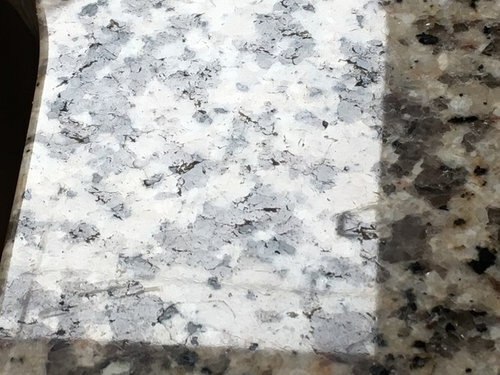
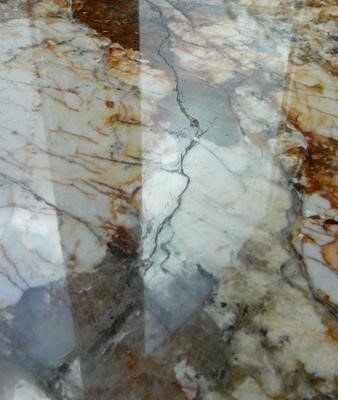
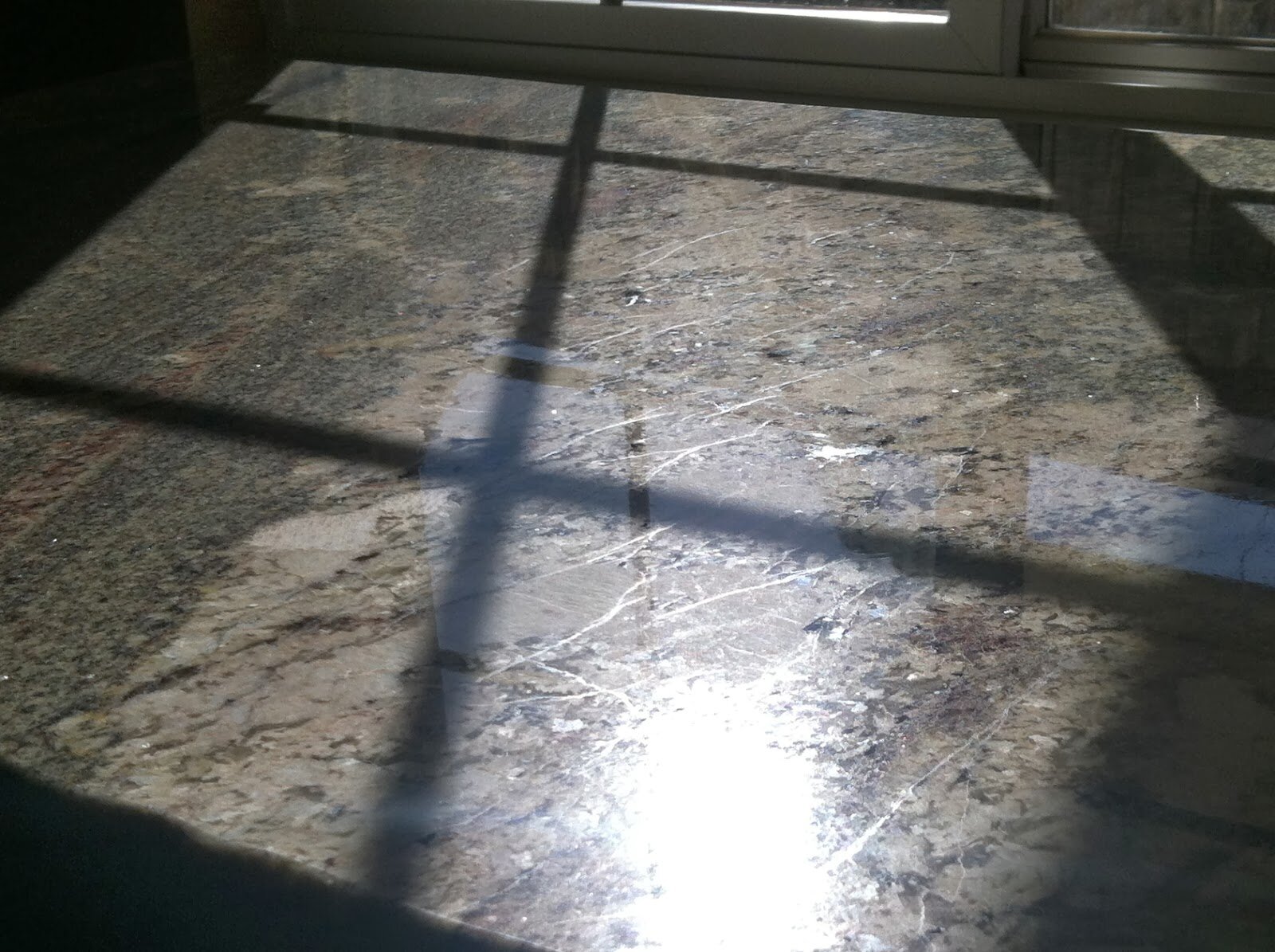
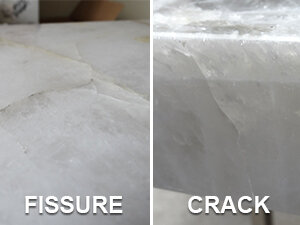
Quartz Surface Care & Maintenance
RESISTANCE TO STAINS AND CHEMICALS
Quartz countertops are non-porous, so spills and stains are not absorbed into the surface making it stain-resistant.
Permanent markers, inks, solvents, dyes, and some chemicals may however cause permanent discoloration to the surface and should be avoided. Should these agents come into contact with the surface, wipe up immediately and rinse with plenty of water. If the stain persists, dampen a cloth with Goo Gone® (or a comparable product) and rub it into the stain. Rinse thoroughly with warm water to remove any cleaner residue.
DO NOT use or expose quartz surfaces to abrasive, alkaline, acidic, free radicals, oxidizers or other pH cleaners. Additionally, DO NOT use or expose quartz surfaces to such products including, but not limited to bleach, oven cleaners, Comet®, Soft Scrub®, SOS®, products with pumice, batteries, paint removers, furniture strippers, oil soaps, tarnish or silver cleaners, or the like. DO NOT use abrasive or harsh scrub pads and DO NOT apply any sealers, penetrants or topical treatments to quartz surfaces under any circumstances. Such products will wear off and cause the gloss to appear dull or inconsistent.
HEAT RESISTANCE
Quartz countertops ARE NOT heat proof, chemical proof or fracture proof in any form. To maintain the beauty of your quartz countertop, DO NOT place hot skillets or roasting pans directly onto the surface. Also be aware of the potential damage to the surface by heat generating appliances such as electric grills or crockpots. We recommend the use of trivets and hot pads to prevent heating the top. As with any natural stone, certain exposure to heat may cause cracks due to thermal shock.
CUTS OR SCRATCHES
Quartz is one of the hardest materials in nature which means your new quartz countertop will not easily scratch or chip. We do, however, recommend the use of a cutting board to protect the surface and avoid dulling your knives.
HOW TO CLEAN SPILLS
It is recommended that simply wiping your top with a soft cloth and warm water is the best cleaning practice 99% of the time. A very small amount of mild soap can also be added if desired. Materials that harden as they dry such as gum, grease, nail polish or paint should be removed by gently scraping away the residue material with a blunt plastic scraper. Next the quartz surface should be cleaned with a household vinegar/water solution (always follow the manufacturer’s dilution instructions) or with a non-abrasive cleaning pad (such as a white 3M Scotch-Brite®) together with a non-bleach, non-abrasive liquid household cleaner. Finally, rinse thoroughly with clean water and dry with a white cloth or paper towel.
ACCEPTED CLEANERS:
· Clorox Anywhere/Clorox Anywhere (Hard Surfaces)
· Simple Green D Pro 3 Cleaner
· Windex/ Windex Multi-Surface Cleaner with Vinegar
· 3M Glass Cleaner
· Denatured/Isopropyl (rubbing) alcohol· Clorox Disinfecting Kitchen Cleaner
· Clorox Wipes Bleach Free Lemon Fresh
· Formula 409 Orange Power Daily Kitchen Cleaner
· Goo Gone
HOW TO DISINFECT
Never use full strength bleach, abrasive powders, or scrubs like Comet®, Soft Scrub®, or S.O.S.® pads. Such products will cause the surface to appear dull or inconsistent. The following list of approved disinfectants meet Centers for Disease Control and Prevention (CDC) guidelines but are deemed safe for your quartz countertop:
· 70 percent isopropyl rubbing alcohol
· Homemade spray mixture of 4 teaspoons of bleach and 1 quart of water.* Let this solution sit on the surface for 30 seconds, then wipe with a dry cloth. Next, rinse the surface with clean water and dry with a soft cloth.
· Lysol® Disinfectant Spray
· Professional Lysol® Disinfectant Spray

